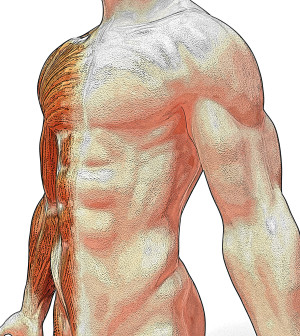- Navigating Your Midlife Crisis: Embracing New Possibilities
- City Raccoons Showing Signs of Domestication
- Mapping the Exposome: Science Broadens Focus to Environmental Disease Triggers
- One Week Less on Social Media Linked to Better Mental Health
- Your Brain Changes in Stages as You Age, Study Finds
- Some Suicide Victims Show No Typical Warning Signs, Study Finds
- ByHeart Formula Faces Lawsuits After Babies Sickened With Botulism
- Switch to Vegan Diet Could Cut Your Greenhouse Gas Emissions in Half
- Regular Bedtime Does Wonders for Blood Pressure
- Dining Alone Could Mean Worse Nutrition for Seniors
Child Sex Trafficking Victims Easily Missed by Doctors, Social Workers: Study


Most health care workers may lack the knowledge, awareness and training to identify potential victims of child sex trafficking, a new study suggests.
“We need to become more aware that trafficking exists and [more] educated about what we can do to identify and provide resources to victims,” said study author Dr. Angela Rabbitt, an assistant professor of pediatrics at the Medical College of Wisconsin in Milwaukee.
Sex trafficking occurs when a child engages in any sexual act, including stripping or engaging in pornography, in exchange for something of value, which could include money, drugs, food, shelter or other survival needs, Rabbitt explained. This legal definition does not require proof of coercion because minors are legally incapable of consenting to sexual activity.
Rabbitt and her colleagues distributed approximately 500 surveys about sex trafficking to doctors, nurses, physician assistants, social workers, and patient and family advocates at hospitals and clinics in urban, suburban and rural parts of southeastern Wisconsin. Of these, 168 were completed, primarily by social workers and physicians.
The survey asked the respondents to read and answer questions about two vignettes, which were scenarios about potential sex trafficking victims. Only half the respondents correctly identified the child in the first scenario as a sex trafficking victim. In the second scenario, 42 percent correctly identified the child as a sex trafficking victim in addition to being a child abuse victim.
The findings were published online March 16 in the journal Pediatrics.
One expert noted the importance of the findings.
“We need more individuals — especially doctors, teachers, youth leaders, coaches, etcetera — to help identify when a child is either at risk for trafficking or currently being exploited,” said Nicole Levy, research project director at the Institute on Domestic Violence & Sexual Assault at the University of Texas at Austin.
“Runaways and homeless youth, youth in the foster care system and youth who have left home due to neglect or abuse are especially vulnerable to trafficking,” she said. “Traffickers and pimps are aware of these vulnerabilities and prey upon such youth — they provide food, shelter, attention and affection.”
Common misconceptions about sex trafficking are that it involves smuggling, transportation or movement across borders or being held against one’s will, Levy said, adding that the average youth’s age of introduction to trafficking is 13.
In the survey, one in five respondents said lack of awareness was a barrier to identifying sex trafficking victims, and about a third said lack of training was an obstacle. Of those surveyed, 63 percent had never received training.
Those with training, however, were more likely to have encountered a victim in their practice, to be more confident about identifying victims, and to say sex trafficking was a major problem in their area.
It’s difficult to determine how many victims of child sex trafficking exist in the United States, Rabbitt said. An estimated 100,000 to 300,000 children and teens under 18 may be at risk. But no centralized database collects reports, research is limited, and victims are often afraid or unwilling to identify themselves or are never asked, she said.
“Trafficking often hides in plain sight — we know that there are trafficking victims whose cases never come to light,” Levy said.
Red flags signaling a possible victim include a history of multiple reproductive or violence-related health problems, such as prior pregnancies, multiple tests for sexually transmitted infections or suspicious injuries, Rabbitt said.
The study authors also reported that 10 percent of providers classified a child victim as a “prostitute” instead of a sex trafficking victim. This reflects “community beliefs that children involved in the sex trade are responsible for their victimization,” the authors wrote.
“I think when the community sees a victim of domestic sex trafficking, their first thought is that he or she is a prostitute who chose that lifestyle,” Rabbitt said. “There is now a growing awareness that many ‘prostitutes’ start out as children or as young adults who were forced into the sex trade, and now, due to fear, addiction or many other reasons, find it very hard to get out of the life.
“For the general community, the best way to prevent a child from becoming a victim of trafficking is to help them develop healthy coping skills and confidence when they are very young, and then continue to support them as they grow,” she said. Volunteering for youth mentoring programs and reporting suspected child abuse and neglect are two ways people can help, she added.
More information
Visit UNICEF for more on sex trafficking.
Source: HealthDay
Copyright © 2025 HealthDay. All rights reserved.










